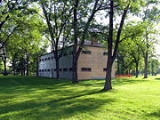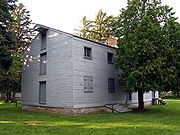
Butler's Barracks
Encyclopedia

Butler's Barracks was the home of Loyalist
Loyalist (American Revolution)
Loyalists were American colonists who remained loyal to the Kingdom of Great Britain during the American Revolutionary War. At the time they were often called Tories, Royalists, or King's Men. They were opposed by the Patriots, those who supported the revolution...
military officer John Butler
John Butler (pioneer)
John Butler was a Loyalist who led an irregular militia unit known as Butler's Rangers on the northern frontier in the American Revolutionary War. He led Seneca and Cayuga forces in the Saratoga campaign. He later raised and commanded a regiment of rangers.-Background:John was born to Walter...
(1728–1796), in what was then Newark, Upper Canada; present day Niagara-on-the-Lake, Ontario
Niagara-on-the-Lake, Ontario
Niagara-on-the-Lake is a Canadian town located in Southern Ontario where the Niagara River meets Lake Ontario in the Niagara Region of the southern part of the province of Ontario. It is located across the Niagara river from Youngstown, New York, USA...
. Butler is most famous for leading an irregular military unit known as Butler's Rangers
Butler's Rangers
Butler's Rangers was a British provincial regiment composed of Loyalists in the American Revolutionary War, raised by Loyalist John Butler.Most members of the regiment were Loyalists from upstate New York...
on the northern frontier during the American Revolutionary War
American Revolutionary War
The American Revolutionary War , the American War of Independence, or simply the Revolutionary War, began as a war between the Kingdom of Great Britain and thirteen British colonies in North America, and ended in a global war between several European great powers.The war was the result of the...
.
The original barracks were constructed in 1778 on the banks of the Niagara River, and were torn down during the construction of Fort George in 1800.
The building currently referred to as Butler's Barracks was constructed in 1818, and the site at one time was quite extensive, being first used by the Indian Department, and later by the British military. It is one of several military sites in the town along the Niagara River
Niagara River
The Niagara River flows north from Lake Erie to Lake Ontario. It forms part of the border between the Province of Ontario in Canada and New York State in the United States. There are differing theories as to the origin of the name of the river...
:
- Fort George, OntarioFort George, OntarioFort George National Historic Site is a historic military structure at Niagara-on-the-Lake, Ontario, that was the scene of several battles during the War of 1812...
- Navy HallNavy HallNavy Hall is a wooden structure encased within a stone structure that was the site of Upper Canada's first provincial parliament in 1792–1796. It is a national historic site located in Niagara-on-the-Lake, Ontario, then known as Newark, Upper Canada...
- Fort MississaugaFort MississaugaFort Mississauga National Historic Site is a fort along the shore of Lake Ontario, not far from the Niagara River in Niagara-on-the-Lake, Ontario. The fort today consists of a box–shaped brick tower and historic star–shaped earthworks—the only one in the country...
The barracks was one of several buildings in the Commons area of the town:
- Commissariat Officer's Quarters and Store (1839) - a -storey house home to the British Commissariat Department
- Junior Commissariat Officer's Quarters (1817) - used as Headquarters Staff, a mess or dining facility for officers, and a residence
- Commandant's Quarters
- Indian Council House (1812?) - became Hospital in 1822
- fuel yard
- storehouses
- Gunshed (1821)
The British
United Kingdom of Great Britain and Ireland
The United Kingdom of Great Britain and Ireland was the formal name of the United Kingdom during the period when what is now the Republic of Ireland formed a part of it....
passed control of the grounds to the Canadian Army in 1871 and became the training grounds and home to the 2nd Division of the Canadian Expeditionary Force.
From October 1917 to March 1919, the barracks became Camp Kosciuszko, home to the Polish Army in France, aka Haller's Army and the Blue Army
Blue Army
The Blue Army, or Haller's Army, are informal names given to the Polish Army units formed in France during the later stages of World War I. The army was created in June 1917 as part of the Polish units allied to the Entente. After the Great War ended, the units were transferred to Poland, where...
. After the war the barracks became Camp Niagara and was used until the 1960s. It is now part of the Fort George National Historic Site.
The Lincoln and Welland Regimental Museum is located in Butler's Barracks. Exhibits include displays and artifacts from the 18th through the present, and include uniforms, weapons, medals, photographs, regimental band instruments, and other memorabilia.

